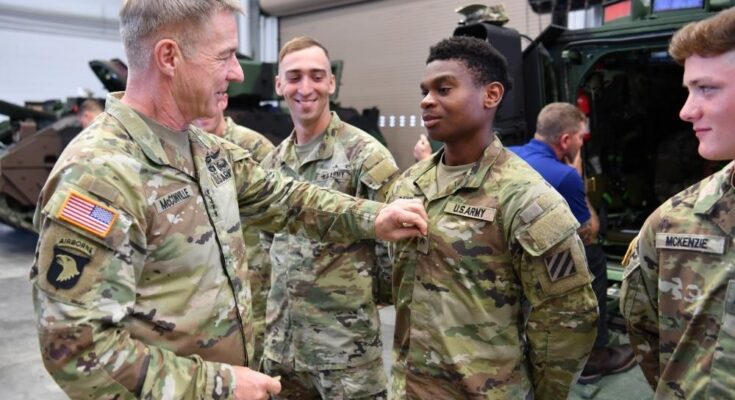United States Armed Forces Recruitment: The United States Armed Forces, revered and recognized globally, has stood as a symbol of power, dedication, and commitment for decades.
The journey of a recruit from a civilian to a soldier is facilitated by meticulously designed recruitment programs. These programs play a pivotal role in shaping the future of the nation’s defense.
Historical Overview of U.S. Armed Forces Recruitment
The rich tapestry of U.S. military history cannot be fully understood without diving into the evolution of its recruitment strategies. From the inception of the nation to its present-day global stature, the methods to attract and enlist the best talents have constantly changed, adapting to the times and needs of the nation.
Early Recruitment Methods and Programs
In the fledgling years of the United States, recruitment was far less structured than we know today. With the Revolutionary War as the backdrop, there was an immediate need for soldiers. Local militias, often made up of citizen-soldiers, played a significant role. These were men who would take up arms in times of need and return to their civilian roles once the crisis had passed. Bounties, or financial incentives, were also used as a lure to get individuals to sign up. However, these methods were fraught with inconsistency, leading to fluctuating troop numbers and varying levels of skill and readiness.
Evolution and Changes Over the Centuries
As the nation matured, so did its military recruitment strategies:
- Civil War Era: The draft was introduced during the Civil War, though it was controversial. Wealthy individuals could pay for substitutes to fight in their place, creating a disparity in who went to the front lines.
- World Wars: The World Wars marked significant shifts in recruitment. With the sheer scale of these conflicts, a more organized draft system was implemented. Propaganda played a crucial role, with posters, films, and other media used to galvanize public support and encourage enlistment.
- Post-Vietnam to Modern Day: After the contentious Vietnam War era, the U.S. military transitioned to an all-volunteer force. The emphasis shifted to offering benefits like education, training, and career opportunities, to attract quality volunteers. Technological advancements also influenced recruitment strategies, with online platforms and sophisticated marketing tactics becoming integral to reaching potential recruits.
However, the journey of U.S. Armed Forces recruitment mirrors the nation’s growth, challenges, and aspirations. From rudimentary enlistment methods to sophisticated, tech-driven strategies, the goal has always been to ensure a robust and ready military force. This historical lens underscores the nation’s commitment to adaptability and the value placed on those who serve.
Modern-Day Recruitment Approaches
In today’s digital era, the U.S. Armed Forces has modernized its recruitment efforts to resonate with the current generation. Some of these state-of-the-art approaches include:
- Virtual Reality (VR) Tours: Prospective recruits can experience military life through VR, offering a unique firsthand perspective.
- Online Aptitude Tests: Before setting foot in a recruitment center, candidates can gauge their potential through online assessments.
- Social Media Campaigns: Platforms like Instagram, Facebook, and Twitter play crucial roles in targeting and attracting potential recruits.
Specialized Recruitment Programs
The vast expanse of the U.S. Armed Forces is dotted with several specialized programs tailored for specific categories of recruits:
- ROTC (Reserve Officers’ Training Corps): This college program prepares young adults to serve as officers in the military. In exchange for a commitment to serve, students receive scholarships and training.
- Military Service Academies: Prestigious institutions like the U.S. Naval Academy and West Point groom young individuals to take up leadership roles in the military.
- OCS (Officer Candidate School): For those who possess a college degree and wish to serve as an officer, OCS is the path. It’s an intensive training program culminating in commissioning.
Incentives and Benefits
To attract the best talent, the U.S. Armed Forces offers numerous incentives:
- Educational Benefits: Programs like the G.I. Bill cover educational costs for servicemen and women.
- Healthcare and Insurance: Comprehensive medical coverage ensures the well-being of recruits and their families.
- Retirement Benefits: Serving in the military can translate into a secure post-service life with pensions and benefits.
Challenges and Opportunities in Recruitment
While the U.S. Armed Forces has a rich history and offers numerous benefits, recruitment is not without challenges:
- Changing Demographics: The evolving demographic landscape demands adaptive recruitment strategies.
- Physical and Mental Fitness Concerns: As warfare tactics evolve, the physical and mental benchmarks for recruits also change, necessitating continuous monitoring.
- Technological Advancements: With warfare becoming technologically advanced, there’s a growing demand for recruits skilled in STEM fields.
However, with every challenge comes an opportunity. By leveraging modern technology and tapping into diverse talent pools, the U.S. Armed Forces is poised to build a robust and resilient team.
Challenges and Criticisms of U.S. Armed Forces Recruitment
Recruitment for the U.S. Armed Forces has always been a significant undertaking, central to ensuring a ready and effective military. However, in recent times, certain challenges and criticisms have come to the forefront.
1. Contemporary Challenges Faced in Recruiting
In the modern era, the U.S. military faces several hurdles in its recruitment efforts. Changing demographics, with a smaller pool of eligible young people due to health, educational, or criminal record reasons, limits the potential recruit base. Additionally, economic upturns often mean that young individuals have more civilian job opportunities, making military service less appealing. Digital distractions and a decreased propensity to serve also play a role, with younger generations less familiar or connected with the military than their predecessors.
2. Public Perceptions and Misconceptions
The Armed Forces constantly grapple with both positive and negative public perceptions. Movies, media, and personal anecdotes shape many of these views, not all of which are accurate. For instance, some see military service as solely combat-oriented, overlooking the vast array of non-combat roles available. Others may harbor misconceptions about the rigor of military life, benefits, or the opportunities for personal and professional growth within the service. Dispelling these myths and ensuring accurate information dissemination is a persistent challenge for recruiters.
3. Ethical Considerations and Debates
Recruitment practices of the U.S. Armed Forces have also sparked ethical debates. Questions arise about the targeting of low-income communities or the “poverty draft,” implying that economically disadvantaged individuals are more incentivized to join due to a lack of alternatives. There’s also the debate over the age of recruits: Is 18 too young to make a decision with such significant implications? Further, the presentation of military service in recruitment materials — whether it overly glamorizes service or understates the risks — is a topic of continued discussion.
However, while the U.S. Armed Forces have a storied history and a significant role in the nation’s defense, the recruitment process is not without its critiques and challenges. Addressing these effectively will be crucial for future recruitment success.
The Future of United States Armed Forces Recruitment
In recent years, the landscape of recruitment for the U.S. Armed Forces has seen unprecedented changes. This evolution is poised to continue, as technological advancements, shifts in the nature of warfare, and the increasing involvement of AI and robotics shape the military of the future. Here’s a closer look at the trends that are redefining military recruitment:
1. Technological Advancements and Their Impact on Recruitment
The digital age has revolutionized many sectors, and military recruitment is no exception. Modern recruitment now heavily relies on digital platforms, social media campaigns, and virtual reality simulations for outreach and training. These tools not only increase the efficiency of the recruitment process but also attract tech-savvy individuals who can handle advanced weaponry and digital equipment. The need for individuals with a high degree of technical proficiency is higher than ever, ensuring that the U.S. military remains agile and competitive.
2. The Evolving Nature of Warfare and Its Implications for Recruitment
Modern conflicts have shifted from traditional battlefields to cyber arenas, space, and other domains. As a result, the U.S. Armed Forces require personnel with diverse skills sets—ranging from cyber specialists who can defend against digital threats, to space experts who can navigate the challenges of extraterrestrial warfare. This paradigm shift has led to a broader scope of recruitment, with a focus on multidisciplinary talents and adaptability in potential recruits.
3. The Potential Role of AI and Robotics in the Future Military
The rise of AI and robotics is no longer the stuff of science fiction. These technologies are fast becoming integral to military operations. As AI-driven drones, autonomous vehicles, and robotic soldiers become more prevalent, the U.S. military will need specialists who can develop, operate, and maintain these advanced systems. This doesn’t mean human soldiers will become obsolete; rather, they’ll work alongside AI entities, harnessing their capabilities for strategic advantage. Recruitment will, therefore, emphasize a blend of technological know-how and human judgment.
However, the future of U.S. Armed Forces recruitment is shaped by a confluence of technology, evolving warfare, and innovative strategies. As the challenges and opportunities of the modern battlefield evolve, so too will the methods and criteria by which the military seeks its next generation of defenders.
Conclusion
The United States Armed Forces Recruitment Programs is not just about numbers but about quality. As the world progresses, the essence of these programs remains unchanged: to attract, train, and retain the best talent for the nation’s defense. With adaptive strategies and unwavering commitment, the future of U.S. military recruitment looks promising.



